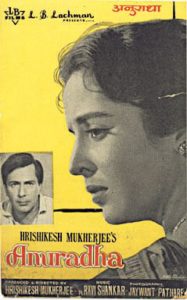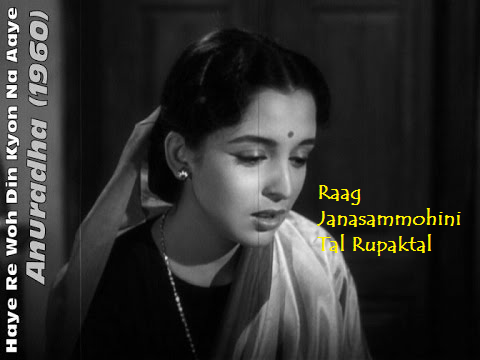Raaga Based Song of the Day: Haye re vo din kyun naa aaye…
Raag Jansammohani, Tal Rupaktal
We have completed twenty-nine days of Raaga Based Songs of the Day. Our first post in the series was titled ‘Raaga Based Song Of The Day #1’ and the song was a Mohammad Rafi and Lata Mangeshkar song from the 1970 Shakti Samanta movie Pagla Kahin Ka: Tum mujhe youn bhula na paoge. It is in Raag Jhinjhoti, Tal Kaherava.
Our twenty-ninth post was titled ‘Raaga Based Song Of The Day #29’ and the song was a Mohammad Rafi and Lata Mangeshkar song from the 1971 HS Rawail movie Mehboob Ki Mehbdi: Itna to yaad hai mujhe. It is in Raag Tilang, Tal Kaherava.
This blog has a number of posts on Raaga based songs in Hindi movies titled similarly; for example: ‘The Best Raaga Based Songs in Hindi Movies – Raaga Yaman – Part I’.
In the last twenty-nine days of sharing Raaga based songs of the day, I have given you songs based on Raag Jhinjhoti, Gara, Bhimpalasi, Madhuvanti, Shivaranjani, Bihag, Pahadi, Sarang, Pilu, Bhairavi, Khammaj, Charukesi, Kalyan or Yaman, Desh, Malgunji, Kirwani, Kedar, Bageshri, Megh Malhar, Bhupali, Ahir Bhairav, Malkaush, Adana, Kafi, Rageshri, Jaunpuri and Tilang.
Today, I give you a song in Raag Jansammohani, Tal Rupaktal.
However, first, lets take up the value added learning of today. Today, we shall learn about Rupaktal:
Yesterday, we learnt about Dhrupad. That’s one style of singing that doesn’t use Rupaktal. However, Rupaktal is otherwise such a common tal that it is to be found in almost all styles of singing in Hindustani Music including Khayal.
Rupaktal distinguishes itself from the other Tals in that the first beat (Sam) is Khali (Wave and not Clap or Taali). The total number of beats (matra) are seven. It is represented by:
wave, 2, 3, clap, 2, clap, 2
that is, unlike the symmetric Tintal, the vibhags (three of them) are not of equal length.
and the Theka is:

As I mentioned, today’s song is composed in Raag Jansammohani, Taal Rupaktal.
Raag Jansammohani or Janasmohini is another raaga of Khammaj Thaat. It is similar to the modern pentatonic (five notes or swar) raaga called Kalavati. The two notes that are omitted in Kalavati are Re (Rishab, the second note) and Ma (Madhyam, the fourth note). If we add Re to Kalavati, we get Janasmohini (and if we add Ma too, we get Khammaj). Indeed, Naushad’s composition in the movie Dil Diya Dard Liya: Koi sagar dil ko behlata nahin, although in Janasmohini, is believed to be closer to Kalavati since there is very little use of Re.
Janasammohini was originally called Siva Kalyan. Little is heard of that raaga now. I have chosen for you a composition by Pandit Ravi Shankar. He brought back the raaga with its original Karnataka name Janasammohini.
The raaga is to be sung during the first prahar of night: 6 PM to 9 PM. The mood that the raaga invokes is that of pangs of separation, nostalgia and remorse.

Indeed, this is exactly the mood in Pandit Ravi Shankar’s composition that I have taken from 1960 Hrishikesh Mukherjee movie Anuradha (Please also read: ‘Bengal Based Hindi Movies From Anuradha To Piku’) with Leela Naidu in the title role as a talented woman fond of singing and indeed being an All India Radio artiste. She falls in love with and gets married to Dr Nirmal Chowdhary (Balraj Sahni). He is an idealist doctor devoting all his time to the patients in the village (after marriage they shift to a village since Nirmal is fired with the idea of bringing relief to the rural people). She feels neglected and has to leave her passion of singing. And that’s how this song came about in the movie.
The other songs composed in Raag Janasammohini are: Aaja re mere pyaar ke raahi, Bhajan bina chain na aaye Ram (the Raag also invokes devotional feelings), and Koi sagar dil ko behlata nahin.
Incidentally, the movie Anuradha won the National Award for Best Feature Film of 1960.
For those extraordinarily poignant lyrics, bringing out her inner feelings, one has to thank one of the greatest lyricists in Hindi movies: Shailendra. And of course, to sing it, is my favourite female singer: Lata Mangeshkar.
Please enjoy in Raag Janasammohini, Tal Rupaktal: Haye re vo din kyun naa aaye…
Haay re vo dinaa kyo.n na aaye
ja ja ke R^itu
ja ja ke R^itu lauT aaye
haay re vo dinaa kyo.n na aaye
Jhilamil vo taare kahaa.N gaye vo saare
man baatii jale bujh jaaye
haye re vo dinaa kyo.n na aaye
Suunii merii biinaa sa.ngiit binaa
sapano.n kii maalaa murajhaaye
haay re vo dinaa kyo.n na aaye
We have intended to learn about Raaga based music whilst we entertain ourselves with Raaga based songs. So, lets, once again, take stock of our collective learning so far:
- On the first day we learnt about the Raaga system devised by Pandit Vishnu Narayan Bhatkhande, which is the prevalent system in Hindustani Classical Music and based on ten Thaats.
- On the second day we learnt about Tal or Taal.
- On the third day we learnt about characteristics of Raagas that included Swar, Jati, Thaat, Arohana and Avarohana, Vadi, Samvadi and Pakad.
- On the fourth day, we learnt about Sargam.
- On the fifth day, we learnt about notations used in Indian classical music or simply Swar Lipi.
- On the sixth day, we learnt about the Ras (sentiments) that Raagas evoke.
- On the seventh day, we learnt about various types of Swar: Shuddha, Achal, Vikrut, Komal and Teevra.
- On the eighth day, we learnt the parts of a composition in Indian Classical Music.
- On the ninth day, we learnt the names of some of the popular instruments used in Indian Classical Music.
- On the tenth day, we learnt about the sources of names of Raagas.
- On the eleventh day, we learnt about why Bhairavi is the first raag to be taught to beginners and also why it is the last in a performance.
- On the twelfth day, we learnt about Khammaj Thaat.
- On the thirteenth day, we learnt about Tal Punjabi Theka or Sitarkhani.
- On the fourteenth day, we learnt about Alap.
- On the fifteenth day, we learnt about List of Raagas (Raagmala) in my favourite book: Sri Guru Granth Sahib.
- On the sixteenth day, we learnt about tips for raaga identification.
- On the seventeenth day, we learnt the basics of Gharana system.
- On the eighteenth day, we learnt about Filmi Sangeet.
- On the nineteenth day, we learnt about the commonest Tal in Raagas: Tintal.
- On the twentieth day, we learnt about the Kafi Thaat.
- On the twenty-first day, we learnt a little more in detail about the classification of Raagas.
- On the twenty-second day, we learnt the essential differences between Bhairavi and Bhairav.
- On the twenty-third day, we learnt a little more in detail about the Jati or Jaati of a raaga.
- On the twenty-fourth day, we learnt details of Thaat Bilawal, the most basic thaat in the Bhatkhande’s system of raagas.
- On the twenty-fifth day, we learnt about Tintal.
- On the twenty-sixth day, we learnt in detail about the Raaga – Samay linkage.
- On the twenty-seventh day, we learnt about Lehar.
- On the twenty-eighth day, we learnt about the history of the Hindustani Music.
- On the twenty-ninth day, we learnt about Dhrupad.
- And today, on the thirtieth day, we learnt about Rupaktal that I was introduced to, a few months back, by my friend Anand Desai.
There is much more still to be learnt and enjoyed.
Please stay tuned!
